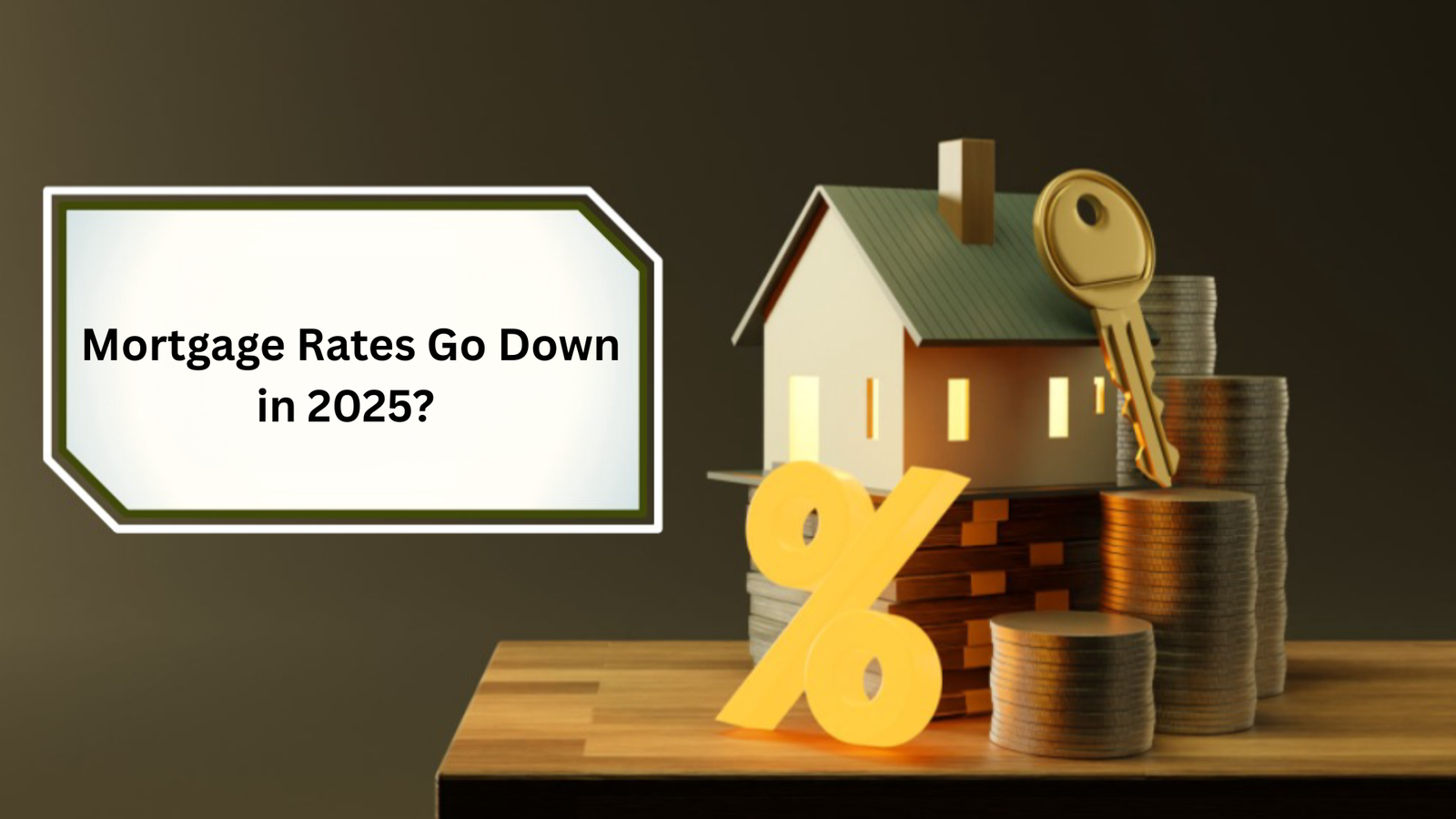Mortgage rates are stuck—and so are millions of hopeful homebuyers. It’s 2025, and despite whispers of relief, 30-year fixed rates still hover around 7%. The question echoing across dinner tables, bank offices, and late-night Google searches: “Will mortgage rates finally go down… or are we trapped here forever?”
If you’ve been waiting for the perfect moment to buy, pause. Because in this article, you’re not just getting predictions—you’re getting power moves:
- The real reason rates refuse to drop (despite Fed cuts)
- What the top housing economists aren’t telling you
- When to act, when to wait—and how to win either way
- Tactical steps to afford your dream home even if rates don’t budge
Whether you’re buying, refinancing, or just dreaming, this isn’t just a forecast—it’s your decoded roadmap to homeownership in 2025. Let’s dive in—and outsmart the market before it outprices you.
Table of Contents
ToggleMortgage Rate Predictions for 2025–2026
We analyzed top housing authorities to bring you the clearest snapshot of where mortgage rates are actually headed—no hype, no guesswork, just the data that moves markets.
Expert Source |
Q3 2025 Rate Forecast |
End of 2025 |
2026 Forecast |
| Freddie Mac | 6.7% | 6.5% | 6.1% |
| Fannie Mae | 6.6% | 6.1% | 5.8% |
| Mortgage Bankers Assoc. | 6.7% | 6.6% | 6.5% |
| National Assoc. of Realtors (NAR) | 6.4% | 6.4% | 6.1% |
| Zillow Home Loans | ~6.5% | ~6.4% | 6.0%–6.1% |
| J.P. Morgan / Wells Fargo | 6.5%–6.7% | 6.5% | 6.3% |
Key Insight: Not a single major forecast expects mortgage rates to fall below 6% in 2025.
But by 2026? A potential sweet spot in the high-5% range may emerge—if inflation, policy, and global volatility align.
Why Mortgage Rates Are Still High in 2025 (Even After 3 Fed Rate Cuts)
You were told rates would fall. But they didn’t. Why? Because mortgage rates don’t follow promises—they follow pressure.
Despite the Federal Reserve slashing rates three times since late 2024, mortgage rates refuse to budge. Here’s why they’re still stuck near 7% and what’s driving this economic tension:
1. The Fed Hit Pause — But Inflation Hit Back
The Fed’s current stance? Cautious optimism.
After aggressive hikes through 2023 and a few cuts in late 2024, the Fed entered a “wait-and-see” mode, holding rates steady to avoid triggering another inflation wave. However, inflation, particularly in housing and energy, remains persistent. That uncertainty? It keeps lenders nervous, and rates, high.
2. Tariffs Are Quietly Fueling Inflation (And You’re Paying the Price)
Under the Trump administration, new tariffs were introduced on imported goods, especially materials tied to home construction like steel, lumber, and aluminum. These added costs ripple through the market, increasing the price of building new homes and reinforcing inflationary pressure. That inflation discourages deeper Fed cuts, which means your mortgage rate stays high.
3. The 10-Year Treasury Yield Is Doing Its Own Thing
You’d think mortgage rates follow Fed cuts? Not quite. Mortgage rates follow the 10-year Treasury yield, and right now, that yield is staying elevated due to global uncertainty, strong job numbers, and rising public debt.
On top of that, lenders are adding a “risk premium,” widening the spread between Treasuries and mortgage rates. Translation? Even if the Fed blinks, your mortgage still pays full price.
4. The U.S. Economy Is Too Strong to Save You
Recession? Not yet. Consumer spending is resilient. Jobs are holding strong. The housing market—even with high rates—is moving. And that’s the problem.
The Fed cuts rates when the economy is weak. But when the economy resists breaking, the Fed resists stimulating. Which means: no urgency to lower rates significantly in 2025.
Bottom Line: Mortgage rates aren’t just numbers—they’re signals. And right now, the signal is clear: The system doesn’t believe the economy is ready, or fragile to warrant deeper cuts. But if you understand what’s causing the resistance. You can outsmart it.
Pro Tip: Want to beat the system?
Lock in when rates dip even slightly. Don’t wait for a mythical 5%. They’re not coming in 2025. Maybe not even 2026.
When Will Mortgage Rates Actually Drop?
Everyone’s asking: “Should I wait?” But the better question is: “What’s coming—and how do I play it?” This is your map of what could happen next.
We’ve broken it into three timelines so you can make the smartest move—whether you’re buying your first home, refinancing, or just stalking Zillow at midnight.
SHORT-TERM (Next 3 Months): Rates Will Flirt, Not Fall
- Expected Range: 6.7% – 7.0%
- Forecast Vibe: Flat, bumpy, indecisive
Despite market hopes, the next Fed meeting isn’t likely to spark a sharp drop. Rates may drift up or down by 10–20 basis points, but no real relief is expected. Why?
The Fed’s in “data-watching mode,” and inflation is still playing peekaboo. If you’re waiting for a big dip in Q3, don’t hold your breath.
Use this time to strengthen your credit and get pre-approved, so you can strike the moment a dip hits.
MID-TERM (By End of 2025): Slight Relief, But No Crash Landing
- Expected Range: 6.3% – 6.5%
- Forecast Vibe: Controlled descent
If inflation continues easing and global volatility stabilizes, most forecasts—Fannie Mae, Freddie Mac, NAR, Wells Fargo—expect modest rate drops by Q4. But forget about 5% fantasies. That’s not on the table this year.
Rates are more likely to drop by 50–70 basis points max—enough to improve affordability, but not cause a buying frenzy.
Lock when rates dip below 6.5%. Waiting longer might cost you the perfect property.
LONG-TERM (2026 and Beyond): Hope for the 5s, But Plan for the 6s
- Expected Range: 5.8% – 6.1%
- Forecast Vibe: Slowly optimistic
By 2026, a combination of:
- Slowing GDP
- Potential rate cuts
- More inventory from new construction
…could bring mortgage rates down into the high 5% range, possibly lower.
But that depends on everything going right—no new trade wars, no inflation spikes, no geopolitical chaos.
Hope is not a strategy. Have a plan for what you’ll do if rates stay high, and what you’ll do if they drop. That way, you’re never caught off guard.
Rate Forecast vs Fed Funds vs 10-Yr Treasury
Timeframe |
Mortgage Rate (Forecast) |
Fed Funds Rate (Target) |
10-Year Treasury Yield |
| Q3 2025 | 6.7%–7.0% | 4.25%–4.5% | ~4.5% |
| Q4 2025 | 6.3%–6.5% | 4.0%–4.25% | ~4.3% |
| End of 2026 | 5.8%–6.1% | 3.5%–4.0% | ~4.0% |
Should You Wait to Buy… or Strike Now Before the Next Wave Hits?
The #1 question buyers are obsessing over in 2025: “Should I wait for rates to fall… or just buy now and refinance later?”
Let’s break the overthinking loop—because the answer isn’t just economic. It’s psychological.
The Truth About “Waiting” in 2025
We’re in what experts call a “rate-locked gridlock.” Millions of homeowners are sitting tight with sub-4% rates, refusing to sell, which means inventory is still tight, and competition is silently creeping back up.
When everyone waits, the smart ones win. Most buyers are sitting on the sidelines right now. That’s your edge.
What’s Happening Right Now?
- Inventory is rising—but only slowly. Not enough to trigger big price drops.
- Prices are sticky, especially in top school districts, suburbs, and Sunbelt metros.
- Most buyers are paralyzed, hoping for a “better rate.”
- Builders are slashing deals quietly to move new homes.
Translation: If you can afford the payment now, you’re in a prime position because you’re not bidding against 10 other people like it was in 2021.
Strategic Move:
Buy now. Refinance later.
- Work with a lender who offers “refi-ready” loans with no fees in year 1.
- Explore 2–1 buydowns, builder credits, or adjustable-rate bridges.
- Get pre-approved and run the numbers for today’s payments, not tomorrow’s hopes.
How to Afford More House — Even with a 7% Mortgage Rate
High rates don’t mean low buying power—unless you think like everyone else.
The smartest buyers aren’t waiting. They’re outmaneuvering the system. Here’s how to do the same.
Most people hear “7% mortgage rate” and assume they’re locked out. But what they don’t realize is, you don’t need a lower rate to afford more.
You need a smarter strategy. These are the 5 proven, lender-approved moves that instantly boost what you can afford, without touching the rate itself.
1. Buy the Rate Down — Like a Pro Investor
You can negotiate your rate lower—yes, even in this market.
- Use mortgage points to buy your rate down
- Negotiate builder-paid or seller-paid buydowns
- Ask lenders about 2–1 or 3–2–1 temporary buydowns
Pro Tip: Every 1% you buy down can slash your payment by $150–$300/month (depending on loan size).
Instead of saying “rates are too high,” reframe to “How can I buy leverage today and refinance freedom tomorrow?”
2. Explore Smarter Loan Types (Don’t Default to 30-Year Fixed)
- 15-Year Fixed: Lower interest rate, faster equity build
- 5/1 ARM: Lower starting rate, ideal if you’ll refinance or move in 5–7 years
- Interest-only loans: Higher risk, but cash-flow-friendly for high-income earners or investors
The question isn’t “What’s safest?”—it’s “What’s most strategic for your timeline?”
3. Supercharge Your Credit Score (Even a 20-Point Jump = Big Savings)
A 740+ credit score unlocks the best rates. Even a shift from 660 → 700 can make a major difference.
- Pay down high balances
- Ask for credit line increases (lowers utilization)
- Dispute outdated negative items
- Don’t open new credit lines before applying
Why it works: Lenders see you as less risky = so they charge you less interest. Think of your credit score as your discount power in disguise.
4. Don’t Accept the First Offer — Shop Like a Shark
3 out of 4 buyers overpay because they never compare rates. Research shows getting just 5 quotes can save buyers up to $3,000+ over the life of the loan.
Script to Use: “I’m comparing rates from 3 other lenders. What’s your most competitive offer?”
Framing creates an urgency + competition trigger in the lender’s mind.
5. Tap Into Hidden Down Payment & Closing Cost Support
You might be eligible for $5,000–$25,000 in assistance without even knowing it.
- First-time buyer grants
- Employer-backed housing support
- City/state-based programs
- Builder + lender rebate combos
What Happens If Mortgage Rates DO Fall? (And Why Waiting Could Backfire)
You’re waiting for rates to drop… but are you ready for what happens next?
A falling rate doesn’t mean a falling price—it means a rising war.
Here’s exactly what happens when mortgage rates go down—and how to profit instead of panic.
1. Refinance Boom = A Frenzy of Applications
If rates fall from 7% to just 6.25%, millions of homeowners from 2023–24 will rush to refinance.
Expect:
- Longer lender response times
- Higher fees (due to demand)
- Delayed closings
The best time to prepare to refinance… is before everyone else realizes it’s time.
2. Buyers Flood the Market — and Inventory Gets Swallowed
Lower rates = higher affordability = mass buyer FOMO.
But housing inventory is still limited. When rates drop:
- Pent-up demand floods the market
- Buyers who waited start bidding wars
- Builders reduce incentives (because they don’t have to give them anymore)
The house that’s sitting quietly today… could have 12 offers tomorrow. Are you okay losing it to someone who moved faster?
3. Home Prices Rise Again (But Silently)
Falling rates increase demand. Increased demand always pressures prices upward. But it won’t look like a surge. It will look like:
- A $20K “builder upgrade”
- Higher closing costs
- Fewer discounts
- No more negotiation power
4. Cash-Out Refinancing Surges — and Equity Moves Back Into Play
Lower rates mean more equity-access opportunity. Expect a surge in cash-out refinances as homeowners tap into 2020–2021 appreciation.
Use cases:
- Debt consolidation
- Renovations
- Buying a second property
5. Lenders Tighten Terms (Yes, Even as Rates Fall)
Most assume lower rates = easier lending. Not always. If too many applicants flood the market:
- Lenders increase credit score requirements
- Discounted rates only go to A+ borrowers
- “Fast-track” approvals go to the highest down payments
Strategic Tip: Improve your credit + docs now, so you’re ready when the window opens.
Stop asking “When will rates fall?”
Start asking: “What will I do when they do—and will I be ready to win or scramble to catch up?”
Don’t wait for a perfect rate—build a perfect plan.
Rates may dip… but not enough to guarantee your dream home or your dream payment.
So here’s what the top 1% of buyers are doing right now:
- Getting pre-approved
- Strengthening their credit
- Learning lender strategy
- Locking when the dip happens—even slightly
- Refinancing when the window opens
You don’t need a low rate. You need a high-level game plan.
FAQs
Will mortgage rates drop in 2025?
Yes, but only slightly. Most expert forecasts (Fannie Mae, Freddie Mac) expect 30-year fixed rates to drift into the 6.3%–6.6% range by late 2025. Not low enough to change the game—just enough to spark more competition.
What is the mortgage rate forecast for the next 5 years?
Here’s the expert consensus as of mid-2025:
Year |
Forecasted Avg. Rate |
| 2025 | 6.3%–6.6% |
| 2026 | 5.8%–6.1% |
| 2027 | 5.5%–5.9% |
| 2028 | 5.3%–5.7% |
| 2029 | 5.1%–5.5% |
Mortgage rates are expected to decline gradually, reaching the high 5% range by 2026–2028.
Should I wait for rates to go below 6%?
Only if you want to buy during a stampede. When rates dip below 6%, buyer competition explodes and prices often rise. Waiting might lower your rate, but raise the total price of your home.
Is 7% a bad mortgage rate?
It’s not great, but it’s not the villain either. In the ‘90s, 7% was normal. In the ‘80s, it was a dream.
What matters more is:
- Your monthly payment
- Your timeline
- Your ability to refinance later
Focus on affordability and flexibility, not the headline rate.
How can I get a lower rate in 2025?
Top 5 tactical moves:
- Buy points (permanent or 2–1 buydown)
- Improve credit score to 740+
- Compare 5+ lenders (unlock up to $3,000 in savings)
- Negotiate with builders/sellers for concessions
- Explore loan types (15-year, ARM, FHA)
To lower your mortgage rate in 2025, boost your credit, compare lenders, and buy points to reduce interest.


